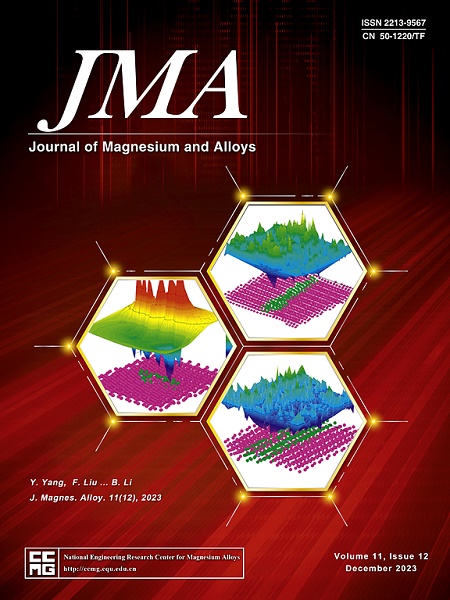Microstructure and mechanical properties of ZK61 magnesium alloy thin-walled cylindrical component processed by two-step forging
IF 15.8
1区 材料科学
Q1 METALLURGY & METALLURGICAL ENGINEERING
引用次数: 0
Abstract
Magnesium alloy thin-walled cylindrical components with the advantages of high specific stiffness and strength present broad prospect for the lightweight of aerospace components. However, poor formability resulting from the hexagonal close-packed crystal structure in magnesium alloy puts forwards a great challenge for thin-walled cylindrical components fabrication, especially for extreme structure with the thickness-changing web and the high thin-wall. In this research, an ZK61 magnesium alloy thin-walled cylindrical component was successfully fabricated by two-step forging, i.e., the pre-forging and final-forging is mainly used for wed and thin-wall formation, respectively. Microstructure and mechanical properties at the core, middle and margin of the web and the thin-wall of the pre-forged and final-forged components are studied in detail. Due to the large strain-effectiveness and metal flow along the radial direction (RD), the grains of the web are all elongated along RD for the pre-forged component, where an increasingly elongated trend is found from the core to the margin of the wed. A relatively low recrystallized degree occurs during pre-forging, and the web at different positions are all with prismatic and pyramid textures. During final-forging, the microstructures of the web and the thin-wall are almost equiaxed due to the remarkable occurrence of dynamic recrystallization. Similarity, except for few basal texture of the thin-wall, only prismatic and pyramid textures are found for the final-forged component. Compared with the initial billet, an obviously improved mechanical isotropy is achieved during pre-forging, which is well-maintained during final-forging.


ZK61镁合金薄壁圆柱件两步锻造组织与力学性能
镁合金薄壁圆柱件具有高比刚度和强度的优点,为航空航天部件轻量化提供了广阔的前景。然而,镁合金六方密排晶体结构导致的成形性差给薄壁圆柱件的制造带来了很大的挑战,特别是对于具有变厚腹板和高薄壁的极端结构。在本研究中,采用两步锻造方法成功制备了ZK61镁合金薄壁圆柱件,其中预锻主要用于焊接成形,终锻主要用于薄壁成形。详细研究了预锻件和终锻件腹板核心、中部和边缘以及薄壁的组织和力学性能。由于应变有效性和金属沿径向流动较大,预锻构件腹板晶粒沿径向均呈拉长趋势,从核心到边缘呈逐渐拉长趋势,预锻过程中腹板再结晶程度较低,不同位置的腹板均呈棱柱状和金字塔状织构。在终锻过程中,由于动态再结晶的显著发生,腹板和薄壁的组织几乎是等轴的。相似的是,薄壁构件除了少量的基底织构外,只有棱柱形和金字塔形织构。与初始坯料相比,预锻过程中力学各向同性得到明显改善,终锻过程中力学各向同性得到很好的保持。
本文章由计算机程序翻译,如有差异,请以英文原文为准。
求助全文
约1分钟内获得全文
求助全文
来源期刊

Journal of Magnesium and Alloys
Engineering-Mechanics of Materials
CiteScore
20.20
自引率
14.80%
发文量
52
审稿时长
59 days
期刊介绍:
The Journal of Magnesium and Alloys serves as a global platform for both theoretical and experimental studies in magnesium science and engineering. It welcomes submissions investigating various scientific and engineering factors impacting the metallurgy, processing, microstructure, properties, and applications of magnesium and alloys. The journal covers all aspects of magnesium and alloy research, including raw materials, alloy casting, extrusion and deformation, corrosion and surface treatment, joining and machining, simulation and modeling, microstructure evolution and mechanical properties, new alloy development, magnesium-based composites, bio-materials and energy materials, applications, and recycling.
 求助内容:
求助内容: 应助结果提醒方式:
应助结果提醒方式:


